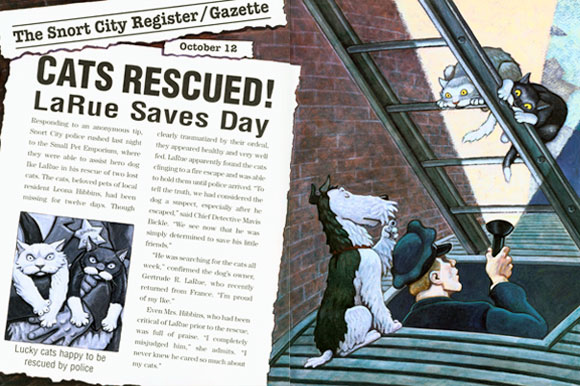
Letters from the Investigation (LaRue Books)
About this book
As if obedience school wasn't bad enough, Ike now finds himself in jail--wrongly accused (of course!) of terrorizing the Hibbins' cats & stealing their cat treats. Once again, he pleads his case to Mrs LaRue, who's vacationing in France, but to no avail. When a string of canary burglaries stalls the Snort City Police force's investigation--and reveals their crime-solving ineptitude--Ike flees custody and takes matters into his own paws. Expect more mad-cap comedy in Ike's daring escapades (real and imagined), as well as ingenious split-screen visuals from the incomparable Mark Teague.Reviews
KirkusReview Date: AUGUST 15, 2004
The captivating canine from Dear Mrs. LaRue: Letters from Obedience School (2002) returns for a second adventure revealed through Ike the dog's letters, this time written from jail. The dapper and dignified Ike has been detained as the prime suspect in the disappearance of two cats from his neighborhood. His plaintive letters to his vacationing owner proclaim his innocence and the cats' guilt as pet birds in the area begin to vanish. Newspaper stories are interwoven into the clever format, which also utilizes the device of one side of each spread in color showing what is really happening juxtaposed against a black-and-white illustration denoting Ike's melodramatic (and fictional) description of his unfair treatment as described in his letters. When Ike escapes from jail, he decides he must "take matters into my own paws." He helps the police capture the cats, followed by a police ceremony naming Ike an honorary detective. Teague's innovative approach to storytelling is fun, but educational as well, skillfully imparting some valuable lessons in point of view and reading between the lines. (Picture book. 5-8)
Booklist
October 15, 2004
K-Gr. 3. In Teague's sequel to Dear Mrs. LaRue 0 (2002), a pair of cats hungry for canary flesh have escaped their apartment and left Ike holding the bag--a bag of incriminating cat treats. "Apparently it is easier for some people to blame a dog than to solve a crime," sniffs the offended Ike in a letter to his vacationing owner. As in the first book, children can tease apart truth from exaggeration by interpolating among the letters, the color scenes of reality, and Ike's gumshoe fantasies, cleverly rendered in black and white. It turns out that the "daring escape" from police custody is really a casual leave-taking ("I'm sure he'll come back when he gets hungry," says the officer in charge); his nighttime investigations are conducted from the comfort of a posh hotel room. The noir-inspired premise drifts farther from doggy reality than the first book's, but children will get a thrill out of piecing together the mystery alongside the wily, self-serving, yet eminently lovable Ike. --Jennifer Mattson Copyright 2004 Booklist
School Library Journal
October 1, 2004
K-Gr 3-As in Dear Mrs. LaRue (Scholastic, 2002), "local dog" Ike LaRue tells his story through a series of misleading letters to his owner. When two neighborhood cats disappear, the pup winds up a jailed suspect. A black-and-white illustration depicts his pitiful plight as he would like Mrs. LaRue to imagine it-sadly blowing on a harmonica in jail. The real situation, in which he shares doughnuts and coffee with a friendly police officer, is revealed in a color illustration on the same spread. This type of juxtaposition continues as Ike slips out to track down the cats on his own. Pictures reveal that the tireless legwork he describes to his owner is actually time spent relaxing in a luxury hotel. Despite his life of ease, the pooch finally does find the missing felines, and he becomes a hero. The contrast between the melodrama of Ike's imagined world and the comfort of his true experiences should elicit many smiles. The placement of the color and black-and-white scenes varies with each spread, which helps prevent the pictorial construct from being predictable or repetitive. Teague's visual characterizations of animals and people are also a treat. Ike displays a variety of emotions and attitudes, often subtly conveyed by posture, facial expression, or even just the tilt of an eyebrow. The cat-bashing references in the dog's letters add another touch of humor to this satisfying epistolary tale.-Steven Engelfried, Beaverton City Library, OR Copyright 2004 Reed Business Information.
Publishers Weekly
July 19, 2004
Last seen heroically saving his owner, Mrs. LaRue, obedience school dropout and creative letter writer Ike returns for another canine caper in this snappy follow-up. This time out, the pooch fond of putting pen to paper is suspected of complicity in the disappearance of Mrs. Hibbins's cats (who happen to be Ike's longtime nemeses). Just as the cats go missing, so do several canaries and other birds from local pet stores. Coincidence? Ike thinks not. Feeling wrongly accused and unfairly detained by police, Ike escapes custody and investigates the Hibbins mystery himself. All the while he keeps Mrs. LaRue, who is on a European vacation, apprised of his progress in letters worthy of a pup with a penchant for melodrama: "An unfortunate misunderstanding (as well as very sloppy police work) has landed me in jail," he writes. Teague once again lets readers in on the fun-viewing the action both as it happens (in full-color scenes) and as embellished in Ike's imagination (featured in black-and-white). For example, the postscript "P.S. Imagine how I feel cooped up inside this loathsome dungeon!" accompanies a color illustration of Ike and a police officer playing a hand of cards in a sunny room, as well as a black-and-white image of Ike being innocently duped by the cats. Lively acrylics paired with comical correspondence result in a picture book that will have Ike fans howling. Ages 4-8. (Sept.) Copyright 2004 Reed Business Information.










